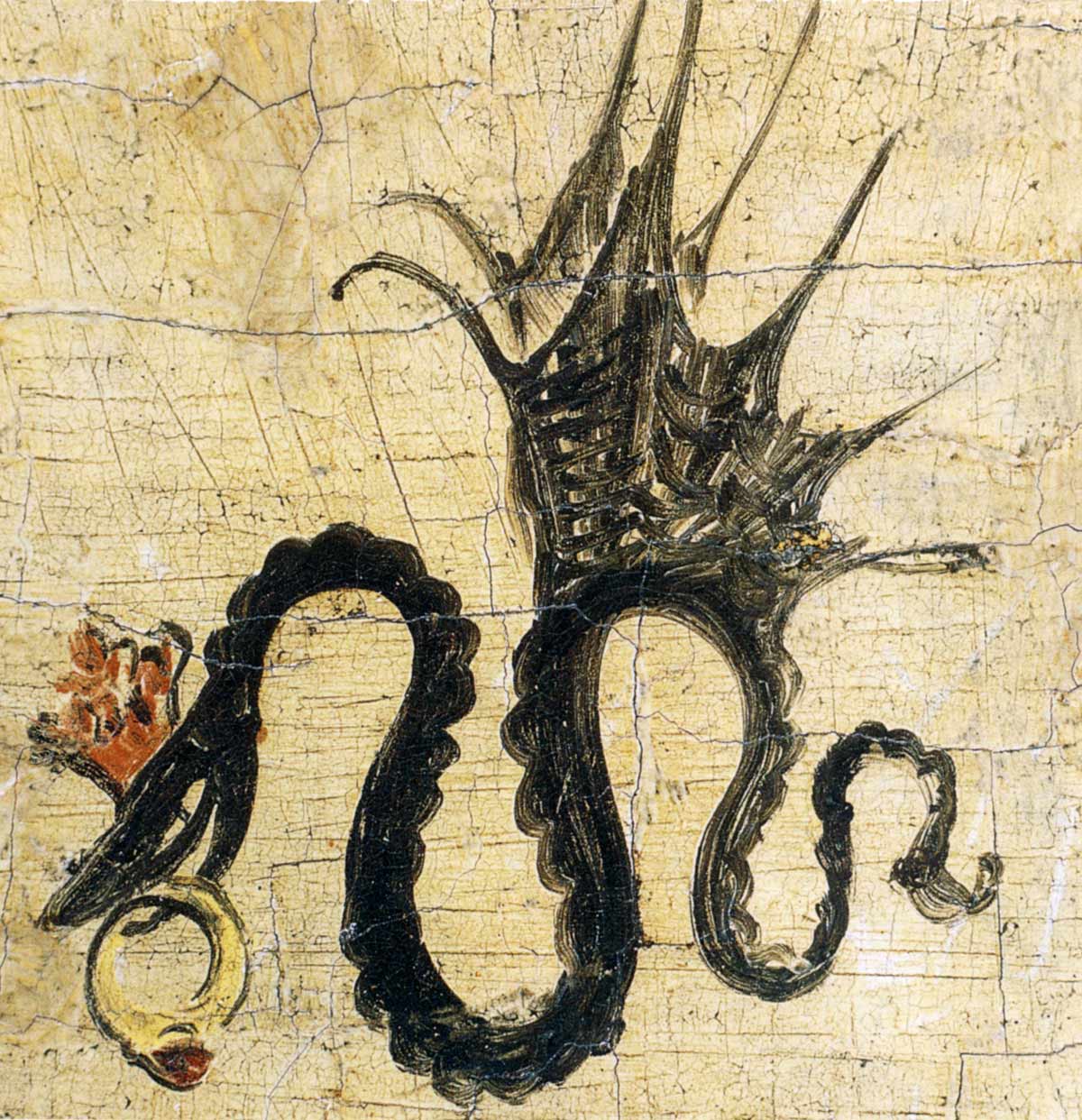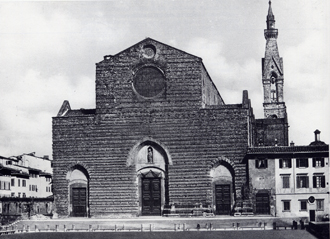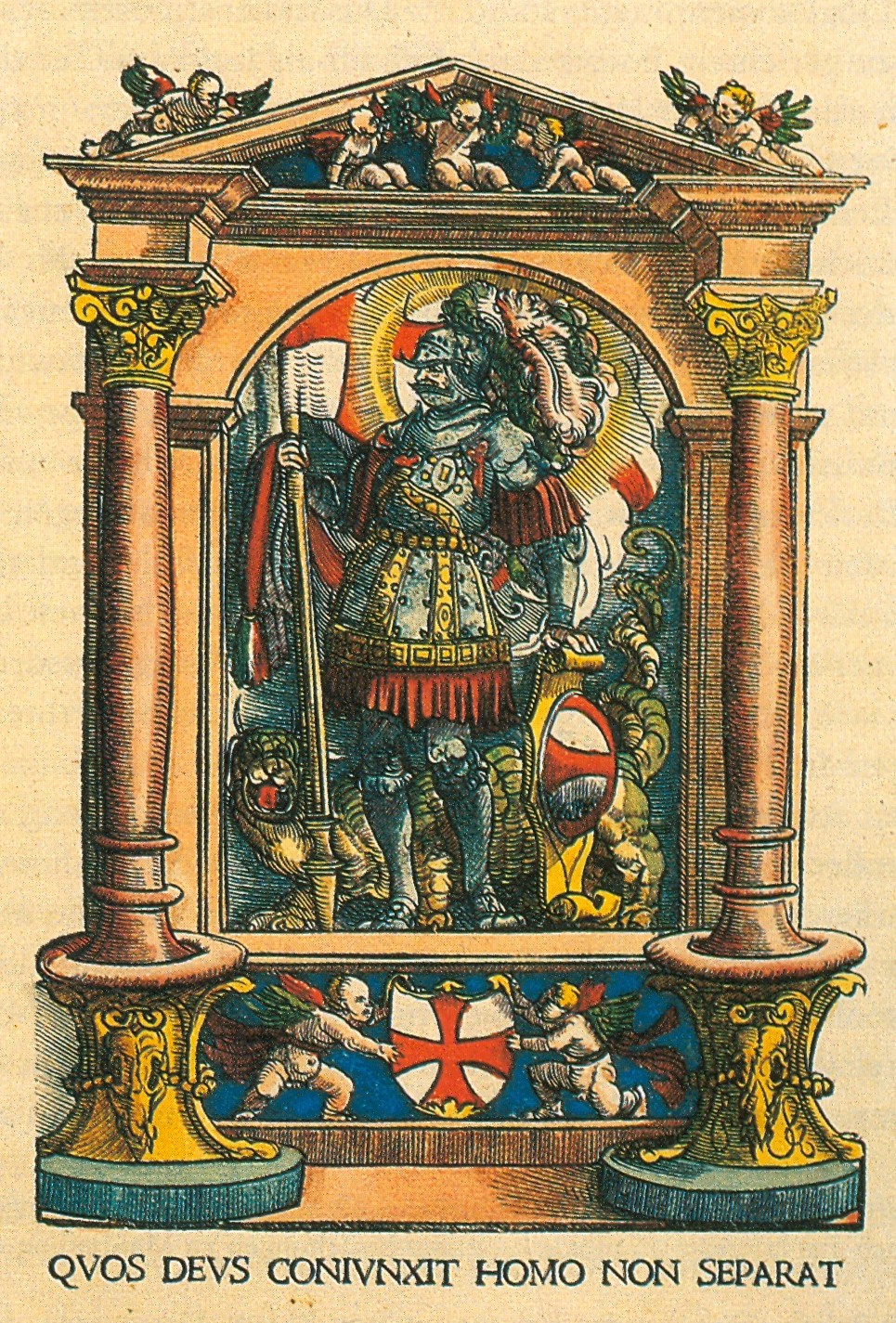|
Fluted Armour
Maximilian armour is a modern term applied to the style of early 16th-century German plate armour associated with, and possibly first made for the Emperor Maximilian I. The armour is still white armour, made in plain steel, but it is decorated with many flutings that may also have played a role in deflecting the points and blades of assailants and increasing the structural strength of the plates. It is a transitional stage in the decoration of armour, after the plain steel surfaces of 15th-century armour and before the elaborate decoration and colouring with etching and other techniques of Renaissance armour. The armour is characterized by armets and close helmets with bellows visors; small fan-shaped narrow and parallel fluting—often covering most of the harness (but never the greaves); etching; work taken from woodcuts; sharply waisted cuirasses, and squared sabatons. According to an alternative version, the name is related to Maximilian II, as the last Maximilian armour wa ... [...More Info...] [...Related Items...] OR: [Wikipedia] [Google] [Baidu] |
Sallet
The sallet (also called ''celata'', ''salade'' and ''schaller'') was a combat helmet that replaced the bascinet in Italy, western and northern Europe and Hungary during the mid-15th century. In Italy, France and England the armet helmet was also popular, but in Germany the sallet became almost universal. Origins The origin of the sallet seems to have been in Italy, where the term ''celata'' is first recorded in an inventory of the arms and armour of the House of Gonzaga, Gonzaga family dated to 1407. In essence, the earliest sallets were a variant of the bascinet, intended to be worn without an aventail or visor (armor), visor. To protect the face and neck, left exposed by abandonment of the visor and aventail, the rear was curved out into a flange to protect the neck, and the sides of the helmet were drawn forward below the level of the eyes to protect the cheeks. The latter development was most pronounced in the barbute or ''barbuta,'' a variation of the sallet that adopted ele ... [...More Info...] [...Related Items...] OR: [Wikipedia] [Google] [Baidu] |
Charles V, Holy Roman Emperor
Charles V (24 February 1500 – 21 September 1558) was Holy Roman Emperor and Archduke of Austria from 1519 to 1556, King of Spain (as Charles I) from 1516 to 1556, and Lord of the Netherlands as titular Duke of Burgundy (as Charles II) from 1506 to 1555. He was heir to and then head of the rising House of Habsburg. His dominions in Europe included the Holy Roman Empire, extending from Germany to northern Italy with rule over the Austrian hereditary lands and Burgundian Low Countries, and Spain with its possessions of the southern Italian kingdoms of Naples, Sicily and Sardinia. In the Americas, he oversaw the continuation of Spanish colonization and a short-lived German colonization. The personal union of the European and American territories he ruled was the first collection of realms labelled " the empire on which the sun never sets". Charles was born in Flanders to Habsburg Archduke Philip the Handsome, son of Maximilian I, Holy Roman Emperor and Mary of Burg ... [...More Info...] [...Related Items...] OR: [Wikipedia] [Google] [Baidu] |
Lucas Cranach The Elder
Lucas Cranach the Elder ( ; – 16 October 1553) was a German Renaissance painter and printmaker in woodcut and engraving. He was court painter to the Electors of Saxony for most of his career, and is known for his portraits, both of German princes and those of the leaders of the Protestant Reformation, whose cause he embraced with enthusiasm. He was a close friend of Martin Luther, and Portrait of Martin Luther (Lucas Cranach the Elder), eleven portraits of that reformer by him survive. Cranach also painted religious subjects, first in the Catholic tradition, and later trying to find new ways of conveying Lutheran religious concerns in art. He continued throughout his career to paint nude subjects drawn from mythology and religion. Cranach had a large workshop and many of his works exist in different versions; his son Lucas Cranach the Younger and others continued to create versions of his father's works for decades after his death. He has been considered the most successfu ... [...More Info...] [...Related Items...] OR: [Wikipedia] [Google] [Baidu] |
Peleș Castle
Peleș Castle ( ) is a Neo-Renaissance palace in the Royal Domain of Sinaia in the Carpathian Mountains, near Sinaia, in Prahova County, Romania, on an existing medieval route linking Transylvania and Wallachia, built between 1873 and 1914. Its inauguration was held in 1883. It was constructed for King Carol I of Romania. Location The complex is northwest of the town of Sinaia, which is from Brașov and from Bucharest. In the southeastern Carpathian Mountains, the complex is composed of three monuments: Peleș Castle, Pelișor Castle, and the Foișor Hunting Lodge. History When King Carol I of Romania (1839–1914), under whose reign the country gained its independence, first visited the site of the future castle in 1866, he fell in love with the magnificent mountain scenery. In 1872, the Crown purchased of land near the Piatra Arsă River. The estate was named the Royal Estate of Sinaia. The King commissioned the construction of a royal hunting preserve and summer ret ... [...More Info...] [...Related Items...] OR: [Wikipedia] [Google] [Baidu] |
Tournament (medieval)
A tournament, or tourney (from Old French ''torneiement'', ''tornei''), was a mock fight that was common in the Middle Ages">Mock_combat.html" ;"title="chivalry">chivalrous competition or Mock combat">mock fight that was common in the Middle Ages and Renaissance (12th to 16th centuries), and is a type of hastilude. Tournaments included Melee, mêlée, hand-to-hand combat, contests of strength or History of archery, accuracy, and sometimes Jousting, jousts. Some considered the tournaments to be frivolous pursuits of celebrity, even a potential threat to public order. But the shows were popular and often put on in honor of coronations, marriages, or births; to celebrate recent conquests or peace treatises; or to welcome ambassadors, lords, or others considered to be of great importance. Other times tournaments were held for no particular reason at all, simply for entertainment. Certain tournaments are depicted throughout the ''Codex Manesse''. Etymology The word ''tournamen ... [...More Info...] [...Related Items...] OR: [Wikipedia] [Google] [Baidu] |
Hermitage Museum
The State Hermitage Museum ( rus, Государственный Эрмитаж, r=Gosudarstvennyj Ermitaž, p=ɡəsʊˈdarstvʲɪn(ː)ɨj ɪrmʲɪˈtaʂ, links=no) is a museum of art and culture in Saint Petersburg, Russia, and holds the largest collection of paintings in the world. It was founded in 1764 when Empress Catherine the Great acquired a collection of paintings from the Berlin merchant Johann Ernst Gotzkowsky. The museum celebrates the anniversary of its founding each year on 7 December, Saint Catherine's Day. It has been open to the public since 1852. ''The Art Newspaper'' ranked the museum 10th in their list of the List of most visited art museums, most visited art museums, with 2,812,913 visitors in 2022. Its collections, of which only a small part is on permanent display, comprise over three million items (the numismatics, numismatic collection accounting for about one-third of them). The collections occupy a large complex of six historic buildings along Palace ... [...More Info...] [...Related Items...] OR: [Wikipedia] [Google] [Baidu] |
Wallace Collection
The Wallace Collection is a museum in London occupying Hertford House in Manchester Square, the former townhouse (Great Britain), townhouse of the Seymour family, Marquess of Hertford, Marquesses of Hertford. It is named after Sir Richard Wallace, 1st Baronet, Sir Richard Wallace, who built the extensive collection, along with the Marquesses of Hertford, in the 18th and 19th centuries. The collection features Fine art, fine and decorative arts from the 15th to the 19th centuries with important holdings of French 18th-century paintings, furniture, arms and armour, porcelain and Old Master paintings arranged into 25 galleries. It is open to the public and entry is free. It was established in 1897 from the private collection mainly created by Richard Seymour-Conway, 4th Marquess of Hertford (1800–1870), who left both it and the house to his illegitimate son Sir Richard Wallace (1818–1890), whose widow Julie Amelie Charlotte Castelnau bequeathed the entire collection to the nat ... [...More Info...] [...Related Items...] OR: [Wikipedia] [Google] [Baidu] |
Santa Croce, Florence
The ( Italian for 'Basilica of the Holy Cross') is a minor basilica and the principal Franciscan church of Florence, Italy. It is situated on the Piazza di Santa Croce, about 800 metres southeast of the Duomo, on what was once marshland beyond the city walls. Being the burial place of notable Italians, including those from the Italian Renaissance such as Michelangelo, Galileo, and Machiavelli, as well as the poet Foscolo, political philosopher Gentile and the composer Rossini, it is also known as the Temple of the Italian Glories (). Building The basilica is the largest Franciscan church in the world. Its most notable features are its sixteen chapels, many of them decorated with frescoes by Giotto and his pupils, and its tombs and cenotaphs. Legend says that Santa Croce was founded by St Francis himself. The construction of the current church, to replace an older building, was begun on 12 May 1294, possibly by Arnolfo di Cambio, and paid for by some of the city's wealthi ... [...More Info...] [...Related Items...] OR: [Wikipedia] [Google] [Baidu] |
Hans Burgkmair
Hans Burgkmair the Elder (1473–1531) was a German painter and woodcut printmaker. Background Hans Burgkmair was born in Augsburg, the son of painter Thomas Burgkmair. His own son, Hans the Younger, later became a painter as well. From 1488, Burgkmair was a pupil of Martin Schongauer in Colmar. Schongauer died in 1491, before Burgkmair was able to complete the normal period of training. He may have visited Italy at this time, and certainly did so in 1507, which greatly influenced his style. From 1491, he worked in Augsburg, where he became a master and eventually opened his own workshop in 1498. Burgkmair was a Lutheran. Career German art historian Friedrich Wilhelm Hollstein ascribes 834 woodcuts to Burgkmair, the majority of which were intended for book illustrations. Slightly more than a hundred are "single-leaf" prints which were not intended for books. His work shows a talent for striking compositions which blend Italian Renaissance forms with the established German style. ... [...More Info...] [...Related Items...] OR: [Wikipedia] [Google] [Baidu] |
Hans Leinberger
Hans Leinberger, sometimes given as Lemberger (c.1475/1480 – after 1531) was a Late Gothic sculptor from Altbayern, who worked in wood, metal and stone. Life and work His exact birthplace is unknown, as is the place and manner of his artistic education. The first documented reference to him involves his residency in Landshut in 1510. The location of his workshop there remains a matter of speculation. After 1516, he did work for Louis X, Duke of Bavaria, who lived there while he was co-regent with his brother William IV. Wage receipts from 1529/30 indicate that he probably held a position similar to an official court artist. None of the works he created in that capacity appear to have survived. He may have been the brother of Georg Lemberger, a painter and woodcut artist who also lived in Landshut, but the relationship is unclear. His fame today rests largely upon the high altar at the Church of Saint Castulus in Moosburg an der Isar. Completed in 1514, it is the large ... [...More Info...] [...Related Items...] OR: [Wikipedia] [Google] [Baidu] |
Burgkmair – S
Hans Burgkmair the Elder (1473–1531) was a German painter and woodcut printmaker. Background Hans Burgkmair was born in Augsburg, the son of painter Thomas Burgkmair. His own son, Hans the Younger, later became a painter as well. From 1488, Burgkmair was a pupil of Martin Schongauer in Colmar. Schongauer died in 1491, before Burgkmair was able to complete the normal period of training. He may have visited Italy at this time, and certainly did so in 1507, which greatly influenced his style. From 1491, he worked in Augsburg, where he became a master and eventually opened his own workshop in 1498. Burgkmair was a Lutheran. Career German art historian Friedrich Wilhelm Hollstein ascribes 834 woodcuts to Burgkmair, the majority of which were intended for book illustrations. Slightly more than a hundred are "single-leaf" prints which were not intended for books. His work shows a talent for striking compositions which blend Italian Renaissance forms with the established German style. ... [...More Info...] [...Related Items...] OR: [Wikipedia] [Google] [Baidu] |








